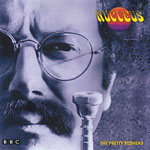Making A Jazzrock Noise
| |

|
Reading Rupert Loydell's review in these pages of the batch of Nucleus re-releases prompted me to remind myself of their place in the jazzrock phenomenon of the early 70's. When Nucleus first appeared theirs seemed a serious sort of music. I listened to various tracks, contemplated buying them but somehow never did. This may have been due to the fact that I preferred Soft Machine's jazz rock mixture. Or perhaps I was more interested in the experiments of Keith Tippett's
group. These Vertigo albums did sound appealing to those, like myself, who
wanted to get into jazz as it appeared to be evolving at the time. Looking back I think either the band or the record company also had a careful eye on the ´rock' audience, hence the debut album's title, ´Elastic Rock'. After all Vertigo did have a predominantly ´rock' roster, albeit with progressive tendencies. So presumably this brought the band to the attention of some who may not have come across Ian Carr's work with Don Rendell and the quintet. There still seems to a good deal of interest in Nucleus as the rash of re-issues and ´live' recordings testifies. These BBC sessions feature two very different incarnations of the band from 1971 and 1982 respectively. The initial recordings showcase the original line-up and I actually think they sound better now. There seems to be more fire in Carr's ´live' playing and Brian Smith's tenor sax is tough and sinuous. This is especially noticeable on ´Song For The Bearded Lady', a Karl Jenkins composition, part of which would later reappear on Soft Machine's ´Bundles'. It also features some excellent choppy guitar from Chris Spedding. I've never had much time for Jenkins as a player or composer but this piece is one of his more laudable ones. He doesn't do much except add electric piano colourings. Jenkins also penned the aforementioned ´Elastic Rock' which is more low-key and typifies the way in which I remember the band at this time; very cool and relaxed. Spedding again contributes a good deal to the overall sound and his solo is suitably understated and controlled. The third track, ´Snakehips Dream' intermittently features what sounds like an electronic snore. I suppose it is really a percussive device but it is an unfortunate distraction. This was one of the last recordings by the original line-up and on the 1982 session only Carr and John Marshall are present. The latter had left earlier as part of the Nucleus exodus and takeover of Soft Machine. This 1982 band had no pianist and guitarist Mark Wood took on chordal and solo duties. It is the only known recording and as such will be on the shopping list of Nucleus collectors. Their sound is pleasant if a little undistinguished. ´Easy Does It Now' is an aptly named example. It has a gentle swing but don't sound as though they are trying despite some busy clankings in the bass region from Joe Hubbard and Marshall's drums clattering everywhere. Things do pick up somewhat on the last track, ´For Miles and Miles' which has a pensive opening and features Carr's muted horn to good effect. They then confounded my expectations and started to rock, Tim Whitehead's soprano driven on by Marshall's muscular attack. After that little flourish the track ends as it began. The band do appear a little redundant by this stage in their career, constant personnel changes stifling any possibility of a ´Nucleus sound' for the eighties. Any strong sense of identity was lost, leaving them sounding like a number of British jazz, rather than jazzrock, outfits. This recording shows that the original idea was probably the best and it is still worth hearing on this set. It just became subsumed in the general plethora of jazz-rock that flourished in those times and the freshness became dulled. © 2003 Paul Donnelly |